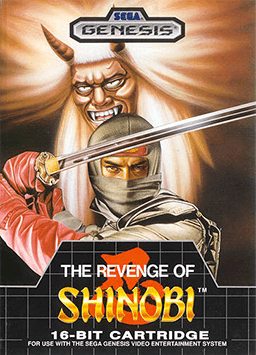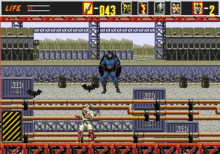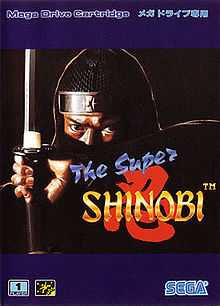The Revenge of Shinobi
| The Revenge of Shinobi | |
|---|---|
 Sega Genesis cover | |
| Developer(s) | Sega (Soft 7) |
| Publisher(s) | Sega |
| Director(s) | Noriyoshi Ohba |
| Designer(s) | Shizuoka Taro |
| Composer(s) | Yuzo Koshiro |
| Series | Shinobi |
| Platform(s) | Sega Genesis, Mega-Tech, Virtual Console, PlayStation Network, Xbox Live Arcade |
| Release date(s) | Genesis Virtual Console PlayStation Network & Xbox Live Arcade |
| Genre(s) | Platform game hack and slash |
| Mode(s) | Single player |
| Distribution | 4 megabit cartridge |
The Revenge of Shinobi, published in Japan as The Super Shinobi (ザ・スーパー忍), is a video game developed and published by Sega in 1989. It was the first Shinobi game developed for the Genesis/Mega Drive, and was later released on the coin-operated version of that console, the Mega-Tech.
Alongside Shadow Dancer, the game is a sequel to Shinobi, and features a soundtrack by video game music composer Yuzo Koshiro. The game was included in the compilations: Mega Games 2, Mega Drive 6 Pak, Sega Classics Arcade Collection (for the Sega CD), and Sega Smash Pack (for the PC and Dreamcast). It was re-released for the Wii Virtual Console in 2009 and on both the PlayStation 3 via PlayStation Network and Xbox 360 via Xbox Live Arcade download services in 2012.[3]
Story
Taking place three years after the first game, the criminal organization Zeed from the original game has since reformed and have renamed themselves "Neo Zeed". They decide to have their revenge on the Oboro Ninja clan and Joe Musashi by killing his master and kidnapping Joe's bride, Naoko (ナオコ). Joe, having reached the clan too late, manages to learn about Neo Zeed's plot by his dying master. Joe decides to travel the world to gain his revenge on Neo Zeed as well as try to save his bride before it's too late.
Gameplay
The game is a traditional side-scrolling platform game. The player controls Joe Musashi and must complete eight districts before the final confrontation with the head of Neo Zeed. Each district consists of three scenes, two of which are platforming levels and the third being a battle against a unique boss-character.
The directional pad moves Joe around while the A, B, and C buttons are used to perform ninjitsu techniques, attack, and jump respectively. A key move in The Revenge of Shinobi is the somersault, which maximizes Joe's jumping height and enables him to throw eight shuriken at once in mid-air. Additionally, some stages consist of multiple layers, such as the first scene of the Military Base and the freeway in Area Code 818. Switching between layer (outdoor/indoor, or on-the-highway/next-to-it) is also done with the somersault move.
Ninjutsu techniques
Although his standard ability of moves and attacks, Joe has the ability to do four special ninjutsu techniques. Only one can be performed in each level, unless a ninjitsu item was picked up, or the ninjutsu of Mijin was used. The four techniques employed by Joe are as follows:
- Jitsu of Ikazuchi (雷の術 Ikazuchi no Jutsu, "Art of Thunder"): Surrounds Joe with a protective shield of lightning energy that sustains damage for four consecutive hits.
- Jitsu of Karyu (火炎の術 Karyū no Jutsu, "Art of the Fire Dragon"): Produces four dragon-shaped columns of flames that move across the screen and damage all enemies in their way.
- Jitsu of Fushin (浮身の術 Fushin no Jutsu, "Art of Self-Levitation"): Improves Joe's jumping ability.
- Jitsu of Mijin (微塵の術 Mijin no Jutsu, "Art of Particles"): Joe explodes, damaging all enemies on screen at the cost of one life. The suicide has the side effect of restoring health and ninjutsu without restarting the stage. If this ninjutsu is used with no lives remaining, the game is over.
Bonuses
A variety of bonus crates can be found in each level, some hidden in the scenery. These include simple powerups such as extra shuriken or health packs, as well as special items to gain lives or extra ninjutsu attacks. Besides powerups, some crates may contain time bombs: explosives that detonate when their fuse runs out or if Joe comes too close (though he can walk out of the blast radius if the player is quick enough).
The game is divided into four difficulties. As difficulty increases, more enemies appear per stage; on Hardest, Musashi takes twice as much damage and the amount of starting lives decreases from 10 to 1. From the options menu, the player can also choose the amount of starting shuriken from 0 to 90 (though a technique does exist that allows infinite shuriken).
Stages
- Ibaraki Province, Japan
- This bamboo forest in the Ibaraki Prefecture is where the game begins. Through these ancient ruins Joe must make his way to The House of Confusion. At the end of this district, he is confronted by the mighty samurai Blue Lobster.
- Tokyo
- Joe begins this stage near a rocky canyon, assaulted by winged ninja. Once he makes it past the waterfalls, the district moves on to the darkened roof tops of Tokyo, and eventually into a blinding disco where Joe must battle with the Shadow Dancer.
- The Military Base U.S.
- This military complex of Neo Zeed is heavily guarded by armed soldiers. Joe will encounter light infantry as well as flame throwers and attack dogs. The second scene takes Joe on board an air carrier; if he touches one of the air locks, he dies. The aircraft is controlled by a powerful supercomputer that houses a human brain.
- Detroit
- Detroit is one big junkyard, heaps upon heaps of cars, running through conveyor belts and into a melting furnace. A tough Terminator-like android guards this wreckage.
- Area Code 818
- Area code 818 takes Joe past skyscrapers and freeways. The final battle is fought on top of an armoured vehicle carrying a gigantic ballistic missile.
- Chinatown
- After a showdown with the kung-fu gangs of Chinatown, Joe hops on board a speeding train. Eventually he finds himself in the clutches of characters resembling Spider-Man and Batman (Devilman for the 1.01 version of the game). In the PAL Mega Drive manual, the boss is described as a single shapeshifting character known as the Web-Bat.
- New York
- Ninja and machine gunners guard the breakwater of New York City's dockside. Leaping from boat to boat, Joe infiltrates Neo Zeed's container ship and comes face to face with Godzilla (turned into a dinosaur skeleton in version 1.03, referred to as a brontosaurus in the PAL manual).
- Neo Zeed Marine Stronghold
- Here is where Joe faces his final enemy, the leader of Neo Zeed. After passing by the Marine, Joe needs to find the right way on a large and well-guarded labyrinth. The beautiful Naoko is trapped somewhere beneath the cellar maze of this stronghold, and Joe must terminate the Boss quickly before the cell trap kills Naoko. There are two endings to the game, depending on whether Joe defeats the Boss in time to save Naoko.
Versions


Because of copyright issues regarding certain enemy characters (many of which were based on cultural icons) there were at least four versions of the game in Japan and North America, with the later two also appearing in Europe.
- Software revision 1.00 (1989): Enemy characters resembling Rambo, The Terminator, Spider-Man, Batman, and Godzilla are present. Both Spider-Man and Batman are actually fake representations of the characters conducted by a shapeshifter who alters his appearance after sustaining a certain amount of damage. Additionally, Joe Musashi's face on the title sequence resembled that of actor Sonny Chiba dressed as his character Hattori Hanzō from the Japanese TV series Shadow Warriors (Kage no Gundan).
- Software revision 1.01 (1989): Batman is replaced by a winged Devilman-like creature. Godzilla and Spider-Man remain unmodified, the latter now morphs into the Devil when defeated. The "Gunner" enemy soldiers with flamethrowers are also changed to bald men with headbands, altering their original likeness to Rambo (although Sega had the license to the character for their Rambo III console games, they did not use it for this game).
- Software revision 1.02 (1990): The fake Spider-Man is now redesigned into the licensed character from Marvel Comics, acknowledged by a copyright notice (Sega already had the license to the character for their game The Amazing Spider-Man vs. The Kingpin). Since he is now the real Spider-Man, he does not morph into the Devil and actually leaves the battle when enough damage is inflicted, with the winged Devil entering to replace him. Godzilla still remains intact.
- Software revision 1.03 (1990): Godzilla is replaced by a skeletal dinosaur. Everything else remains intact from the previous revision, including the licensed use of Spider-Man. This version was used in the Genesis 6-Pak cartridge along with the "Sega Classics" edition of the game.
- Software revision 1.04 (2009/2012): Since the licensed use of the boss Spider-Man was for a limited period of time, the game was subsequently prevented from being re-released years later. The 2009 release for the Virtual Console as well as the Xbox Live Arcade and PlayStation Network 2012 releases features a new specific software revision (1.04) that omits the Marvel copyright notice and replaces Spider-Man with a pink palette swap of the character that still behaves the same as the licensed Spider-Man.[4] Joe Musashi's design in the title screen was also altered to remove his likeness to Sonny Chiba.
The credit roll, shown during the ending, was removed from the North American version of the game.
In versions 1.00 and 1.01, "©SEGA 1989 / MUSIC ©1989 YUZO KOSHIRO" would be shown at the bottom of the title screen like normal; when the Spider-Man copyright notice was added to the game, all copyright bylines were moved to a screen displayed before the intro.
Sega Smash Pack
The version included in volume 1 of the PC Smash Pack collection appears to be a prototype version. The internal ROM date says March 1989, and the product number is filled with zeroes. In the notes section of the ROM header (at 0x1C8), there is the string, "A0115 Sega_Channel", whereas all other releases have that area filled with ASCII space characters. The header also is only marked as being a Japanese release, while all other versions are marked as Japanese, US, and European.
The title screen always uses The Super Shinobi regardless of the console region. The game has an invincibility mode in the options screen, and a level select at the main menu. Enabling invincibility also gives infinite lives from falling off screen, out open doors, and using Mijin (it also prevents you from gaining lives). There are other changes found in the options menu: the shuriken option is spelled "syurikin" (in other versions, it's spelled "shurikin"), and the sound test option lacks music titles, showing only a hex number (in other versions, sound effects are numbered in decimal).
There is no copyright screen. The introduction uses the final version Round 1 music (The Shinobi) instead of its own theme. The sound effect when Musashi changes his grip does not play, and the sparks when the shuriken hit the sword stay on screen longer. There are no demos other than the opening animation (i.e. no plot text or gameplay demos).
Using Mijin uses up ninjitsu; in other versions ninjitsu is still available after using Mijin. Mijin also remains selected after it has been used, instead of switching to Ikazuchi. There is also no shouting sound effect when ninjutsu are activated.
The final game has 19 music tracks, but this version only has the first 7 (the order of music in the sound test is unchanged). Because of this, there are differences in what music is used for what Round, but even when the music is in all versions, different tracks are used. The music used in 1-1 is China Beat, and 1-2's music is Make Me Dance while in the final, both stages use The Shinobi. The game over screen has no music and is missing Zeed's laughter. The drum samples used throughout the game are also different.
For the most part, the enemies resemble the REV00 versions with the exception of Spider-Man, which is red and blue instead of red and black. However, he is still missing the eye mask.
Some bosses appear incomplete. The Godzilla boss of Round 7 seems to be invincible, and the fight ends after the boss goes through a few attacks. The Round 3 and 8 bosses appear to be missing completely (although the maps themselves are there); the game switches to the end of level screen shortly after starting. There is no ending either: the game loops back to Round 1 after 8-3.[5]
Reception
| Reception | ||||||||||
|---|---|---|---|---|---|---|---|---|---|---|
| ||||||||||
| ||||||||||
The game received 5 out of 5 stars in Dragon; the final boss battle was criticised, however, for being too difficult.[9] MegaTech magazine praised the "smart gameplay, graphics and sound". Mega placed the game at #18 in their Top Mega Drive Games of All Time.[10] Reviewing the game's appearance in Sega Arcade Classics, Glenn Rubenstein said it "was one of the first Genesis games released, and it shows how far Sega has come since then."[8]
Legacy
A suite of music from the game was performed live by an orchestra at the Fourth Symphonic Game Music Concert in 2006 at the Gewandhaus zu Leipzig, Germany. The arrangement was done by original composer Yuzo Koshiro himself. Music from The Revenge of Shinobi was also performed at two concerts of PLAY! A Video Game Symphony in Stockholm, Sweden in 2007. It was also played during the encore as the most voted song when PLAY! A Video Game Symphony was performing in Singapore (June 2007).
References
- ↑ "Fun Keeps Popping Up, From Slot Cars to Rock Stars, Sudoku to Ninjutsu". Nintendo. 2009-08-17. Retrieved 2009-08-17.
- ↑ "The Revenge of Shinobi". Ps3.gamespy.com. Retrieved 18 December 2014.
- ↑ "Lots of Sega classics confirmed for XBLA, PSN". Computerandvideogames.com. Retrieved 18 December 2014.
- ↑ Nintendo Life. "Spidey goes pink in The Revenge of Shinobi". Nintendo Life. Retrieved 18 December 2014.
- ↑ "The Revenge of Shinobi – The Cutting Room Floor". Tcrf.net. Retrieved 2013-07-26.
- ↑ MegaTech rating, EMAP, issue 5, page 78, May 1992
- ↑ Mega rating, issue 9, page 23, Future Publishing, June 1993
- ↑ 8.0 8.1 Rubenstein, Glenn (January 1993). "At the Controls". Wizard (Wizard Entertainment) (17): 21–24.
- ↑ Lesser, Hartley; Lesser, Patricia; Lesser, Kirk (November 1990). "The Role of Computers". Dragon (163): 47–50.
- ↑ Mega magazine issue 1, page 76, Future Publishing, Oct 1992
External links
- Official website (Japanese)
- The Revenge of Shinobi at MobyGames
| ||||||||||||||||||||||||||
| ||||||||||||||||||||||||||||||||||||||